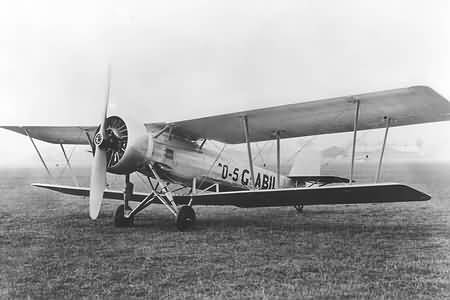- Vickers Vespa
infobox Aircraft
name = Vespa
type = Army Cooperation Aircraft
manufacturer =Vickers Limited 
caption = The Vickers Vespa VII which reached a world altitude record
designer =
first flight = 1925
introduced = 1928
retired = 1940
status =
primary user =Bolivia
more users =Irish Air Corps
produced =
number built = 15
unit cost =
developed from =
variants with their own articles =The Vickers Vespa was a British
army co-operation aircraft designed and built byVickers Limited in the 1920s. While not adopted by Britain'sRoyal Air Force , small numbers were brought by theRepublic of Ireland andBolivia , the latter of which used the type during theChaco War . One modified Vespa was used to set a world altitude record of 43,976 ft (13,407 m) in September 1932.Design and development
The Vespa was designed by Vickers as a private venture to meet the requirements of
Air Ministry Specification 30/24 [The only other aircraft designed to meet this specification was the Short S.3b Chamois,] the first prototype, the Vespa I being flown in September 1925. Mason 1994] The Vespa, which was a single enginedbiplane with a slim fuselage suspended between closely spaced and highly staggered two bay wooden wings, was delivered for evaluation by theRoyal Air Force , but crash landed owing to engine trouble on24 June 1926 and was badly damaged.Andrews and Morgan 1988] It was then rebuilt with steel, fabric covered wings as the Vespa II, but this was unsuccessful in getting orders from the RAF.It did, however, attract attention from
Bolivia , which ordered six Vespa IIIs, an improved all metal version, in 1928, and theRepublic of Ireland , which ordered four Vespa IVs in 1929 and a further four Vespa Vs in 1930.The prototype Vespa was modified as the Vespa VI for demonstration to the Central Chinese government, but was not purchased, so was returned to Britain. It was rebuilt as the Vespa VII, with a supercharged
Bristol Pegasus S engine for an attempt on the world altitude record, setting a record of 43,976 ft (13,407 m) on16 September 1932.Operational history
Six Vespa IIIs were delivered to Bolivia in 1928, where they were mainly used as operational conversion aircraft, although they did see limited use in the
Chaco War . They remained in service until 1935. [ "Aeroflight World Air Forces - Bolivian Air Force". [http://www.aeroflight.co.uk/waf/americas/bolivia/Bolivia-af-CMA.htm] Access date:9 June 2007 .]The eight Irish Vespas remained in service for several years, operating from the
Irish Air Corps base at Baldonnel, nearDublin , with the last being written off on12 June 1940 . ["Irish Air Corps Aircraft 1922-1997". [http://www.iol.ie/~asire/aircorps.html] Access date:9 June 2007 .]Variants
;Vickers Type 113 Vespa I: Prototype army co-operation aircraft for evaluation by RAF. Wooden wings. Powered by
Bristol Jupiter IVradial engine (later fitted with Jupiter VI. One only ("G-EBLD");Vickers Type 119 Vespa II: Vespa I modified with metal wings.;Vickers Type 149 Vespa III: Improved all metal production version for Bolivia. Powered by 455 hp Jupiter VI engine. Six built.;Vickers Type 193 Vespa IV: Production version for Irish Air Corps. Powered by 490 hpArmstrong Siddeley Jaguar VIC. Four built.;Vickers Type 208 Vespa V: Improved version of Vespa IV for Irish Air Corps. Fitted withTownend ring around engine. Four built.;Vickers Type 210 Vespa VI: Rebuilt first prototype, re-registered as "G-ABIL" and demonstrated to Central Chinese government. ;Vickers Type 250 Vespa VII: Vespa VI rebuilt with Bristol Pegasus S engine for altitude record attempt.Operators
;BOL
*Bolivian Air Force ;IRL
*Irish Air Corps ;UK
*Royal Air Force pecifications (Vespa V)
aircraft specifications
plane or copter?=plane
jet or prop?=prop
ref=Vickers Aircraft Since 1908
crew=Two
capacity=
length main= 33 ft 0 in
length alt= 10.06 m
span main= 50 ft 0 in
span alt= 15.24 m
height main= 10 ft 6 in
height alt= 3.20 m
area main= 576 ft²
area alt= 53.5 m²
airfoil=
empty weight main= 2,882 lb
empty weight alt= 1,310 kg
loaded weight main= 4,370 lb
loaded weight alt= 1,986 kg
useful load main=
useful load alt=
max takeoff weight main=
max takeoff weight alt=
more general=
engine (prop)=Armstrong Siddeley Jaguar VIC
type of prop= 14 cylinder air cooledradial engine
number of props=1
power main= 490 hp
power alt= 366 kW
power original=
max speed main= 121 knots
max speed alt= 139 mph, 224 km/h
cruise speed main=
cruise speed alt=
never exceed speed main=
never exceed speed alt=
stall speed main=
stall speed alt=
range main= 504 nm
range alt= 580 mi, 934 km
ceiling main= 26,000 ft
ceiling alt= 7,900 m
ceiling more=absolute ceiling
climb rate main=
climb rate alt=
loading main= 7.59 lb/ft²
loading alt= 36.2 kg/m²
thrust/weight=
power/mass main= 0.11 hp/lb
power/mass alt= 0.18 kW/kg
more performance=*Climb: 16 min to 15,000 ft (4,600 m)
guns=One forward firing .303 in (7.7 mm)Vickers machine gun and one 0.303 inLewis gun onScarff ring in rear cockpit
avionics=ee also
aircontent
related=
similar aircraft=
lists=
*List of aircraft of the RAF
see also=References
Notes
Bibliography
* Andrews, C.F. and Morgan, Eric B. "Vickers Aircraft since 1908, Second edition". London: Putnam, 1988. ISBN 0-85177-815-1.
* Donald, David, ed. "The Encyclopedia of World Aircraft". London: Aerospace Publishing, 1997. ISBN 1-85605-375-X.
* Mason, Francis K. "The British Bomber since 1914". London: Putnam Aeronautical Books, 1994. ISBN 0-85177-861-5.External links
* [http://avia.russian.ee/air/england/vickers_vespa.php Virtual Aircraft Museum]
Wikimedia Foundation. 2010.
